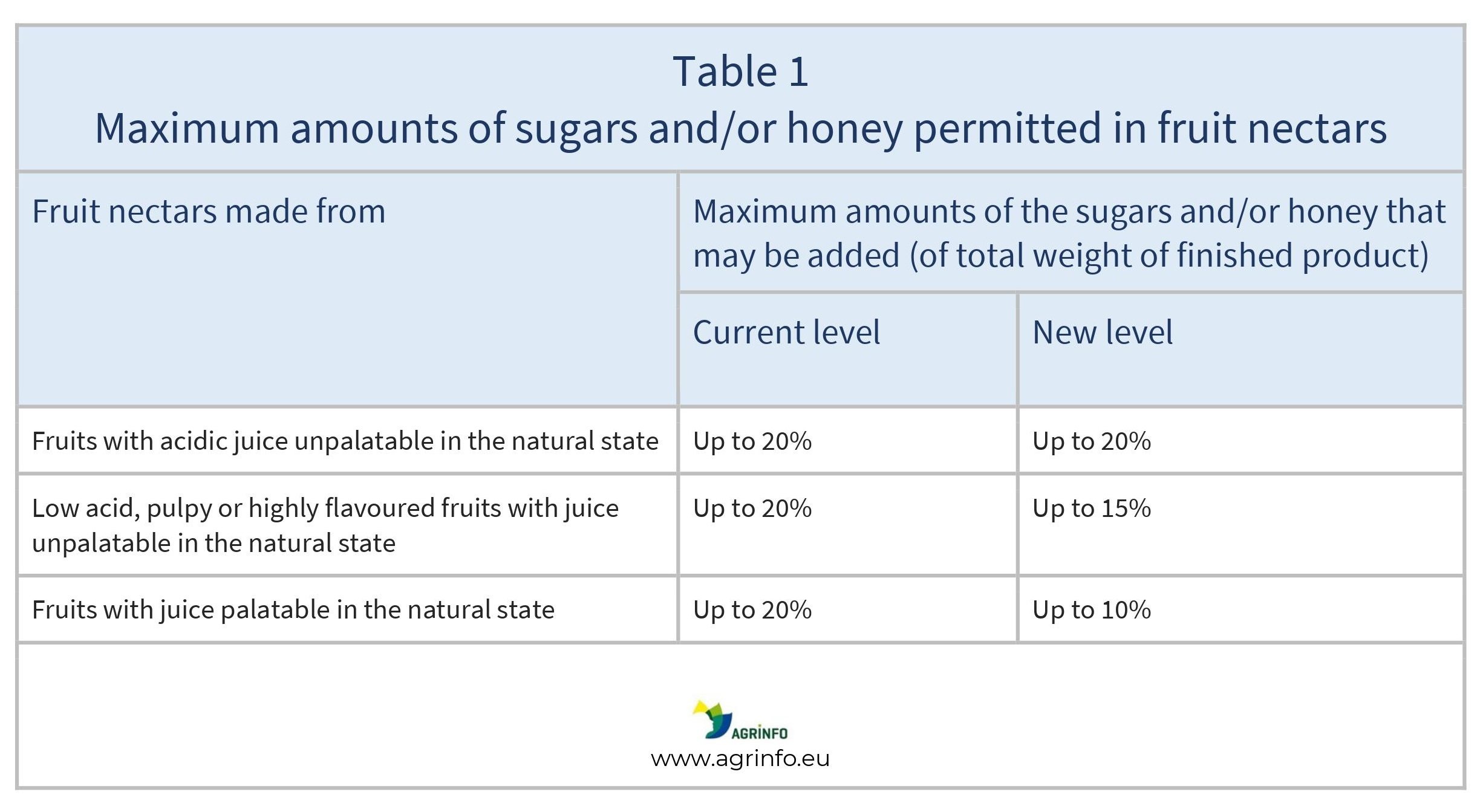Revised marketing standards for honey, fruit juices, fruit jams, and preserved milk
Published by AGRINFO on ; Revised
EU revises marketing standards for honey, fruit juices, fruit jams, and preserved milk
Directive (EU) 2024/1438 of the European Parliament and of the Council of 14 May 2024 amending Council Directives 2001/110/EC relating to honey, 2001/112/EC relating to fruit juices and certain similar products intended for human consumption, 2001/113/EC relating to fruit jams, jellies and marmalades and sweetened chestnut purée intended for human consumption, and 2001/114/EC relating to certain partly or wholly dehydrated preserved milk for human consumption
Update
The EU has updated the marketing standards for honey, fruit juices and nectars, fruit jams, jellies and marmalades, and preserved milk, aligning them with the EU’s Farm to Fork strategic goal of encouraging healthier diets among EU citizens. The new rules introduce stricter rules of origin labelling for honey; add a new category of reduced-sugar fruit juices; raise the minimum quantity of fruit to be contained in jams; and permit the treatment of milk to reduce lactose content.
Impacted Products
honey, fruit juices, fruit jams, preserved milk
What is changing?
The new Directive introduces the following major changes.
Honey
Amendments to Directive 2001/110/EC
Origin labelling
Under current rules, a blend of honey from multiple countries may be labelled “blend of EU honeys”, “blend of non-EU honeys”, or “blend of EU and non-EU honeys”. This labelling was considered to potentially mislead consumers. Under the new rules, all the countries of origin must be indicated on the label in the principal field of vision, including the percentage of honey from each country, listed from largest to smallest in terms of its share in weight in the honey blend. A margin of tolerance of 5% is permitted for each individual share within the blend.
To provide flexibility, individual EU Member States may allow in their national legislation an alternative option where the four largest shares, if together they form more than 50% of the blend, should indicate the percentage of each, and the remaining countries of origin do not have to indicate the percentage.
Small packs
For small packs of less than 30 g, the names of the countries of origin may be replaced by a two-letter code in line with ISO 3166.
Filtered honey
Annex I of Directive 2001/110/EC sets out the names and definitions of different types of honey (blossom or nectar, honeydew, comb, chunk or cut comb, drained, extracted, pressed, filtered, baker’s). Under the new rules, the term “filtered honey” is removed as it had little meaning in terms of pollen quantities. Its definition is now incorporated into the definition of baker’s honey, i.e. if a significant amount of pollen is removed, the honey must be called baker's honey.
Methods of analysis
The EU will adopt laws on methods of analysis to detect adulterated honey before June 2028. Until then, EU Member States should use internationally recognised methods of analysis such as those approved by the Codex Alimentarius.
Combating adulterated honey
Due to concerns about adulterated honey, the new Directive also allows the Commission to adopt further rules on composition criteria in the future, for example on the pollen content for certain types of honey, and on the traceability of honey. In addition, the new rules establish a honey-specific platform aimed at:
- gathering data for methods to improve authenticity controls of honey
- providing recommendations for an EU traceability system, composition criteria, and the establishment of an EU reference laboratory for honey.
Fruit juices and fruit nectars
Amendments to Directive 2001/112/EC
EU law distinguishes between fruit juices, concentrated fruit juice (with at least 50% water content removed), fruit juice from concentrate (where water has been re-added to concentrated fruit juice), and fruit nectar (combining juices with fruit purée). The definitions and characteristics of these products are set out in the Annex to Directive 2001/112/EC.
New categories of fruit juices created
New processing techniques remove naturally occurring sugars in response to consumer demand for products with lower sugar content. The resulting sugar content is lower than that of juice extracted from fruit. Under current rules, such products cannot be called “fruit juice”.
This Directive creates a new category for products that have reduced naturally occurring sugars, but otherwise keep the essential characteristics of fruit juice. These are “reduced-sugar fruit juice”, “reduced-sugar fruit juice from concentrate”, or “concentrated reduced-sugar fruit juice”. The sugar content must be reduced by at least 30% compared to the average type of juice. The use of sweeteners is not allowed. The definitions of these new products are added to Directive 2001/112/EC Annex I, Part I, and the new processing techniques are included as authorised treatments in Part II, point 3. Further rules on the chemical, organoleptic, and nutritional characteristics of reduced-sugar products will be established by the Commission at a later stage.
Reduction of amount of sugars permitted in fruit nectars
Fruit nectars are currently permitted to contain added sugars and/or honey up to 20% of the total weight of the finished products. Under the new rules, these maximum levels of sugar content are reduced for certain categories of fruit nectars (see Table 1).
Fruit juices may be labelled as “containing naturally occurring sugars”
Under current rules, fruit nectars, but not fruit juices, may be labelled with “contains naturally occurring sugars”. This is considered potentially confusing for consumers. Under the new rules, “fruit juices contain only naturally occurring sugars” is allowed to appear on fruit juices in the same field of vision as the name of the product.
Coconut juice
The use of the term “coconut water” is added as a designation that may be used as a synonym for “coconut juice” (Directive 2001/112/EC, Annex III). Coconut with a maximum Brix level of 4.5 (1° Brix = 1 g sucrose in 100 g solution) is added to the list of fruits and maximum Brix levels for reconstituted fruit juice and reconstituted fruit purée (Directive 2001/112/EC, Annex V).
Sunflower seeds
Sunflower seeds are added to the list of authorised sources of plant proteins for use in clarification of fruit juices (Directive 2001/112/EC Annex I, Part II, point 3).
Fruit jams, jellies, and marmalades
Amendments to Directive 2001/113/EC
Quantity of fruit
The minimum quantity of fruit pulp or purée to be used in “jams” and “extra jams” is increased (see Table 2). As under current rules, the same minimum quantities apply for “jellies” and “extra jellies” (taking into account the weight of water used).
Reduced-sugar alternatives
Jams, jellies, and marmalades must currently have a soluble dry matter content of 60% or more. As the minimum quantity of fruit is increased, the amount of added sugar needed to reach 60% is reduced. This could make it difficult to produce jams that can only be marketed as “reduced sugar” if there is a 30% reduction in sugar compared to similar jams (under Regulation 1924/2006 on nutrition and health claims). To encourage the continued production of reduced-sugar jams, under the new rules, jams that fulfil the 30% reduction in sugar requirement do not have to meet the 60% soluble dry matter threshold (Directive 2001/113/EC, Annex I, Part II).
Marmalade
This term is currently defined in relation to citrus fruits. However, in some EU Member States the terms “jam” and “marmalade” are used interchangeably and do not always refer to citrus fruits. Under the new Directive, Member States may authorise the use of the term “marmalade” or “extra marmalade” in their territory for products that fulfil the criteria of “jam” or “extra jam”, respectively. To avoid confusion, marmalade fulfilling the current criteria for marmalade, i.e. made from citrus fruit, is called “citrus marmalade”.
Concentrated fruit juice as an ingredient
The list of additional ingredients that may be used in products (given in Directive 2001/113/EC, Annex II) is amended to allow the use of concentrated fruit juice. Concentrated produce is less heavy to transport, more stable, and can be preserved for longer, making it more sustainable than fresh fruit juice.
Origin labelling
The new Directive does not establish mandatory origin labelling for jams, but invites the Commission to present a report on the feasibility of introducing origin labelling by mid-2027.
Preserved milk
Amendments to Directive 2001/114/EC
The new Directive will:
- allow treatment of milk that reduces lactose content by converting it to glucose and galactose (Directive 2001/114/EC, Annex II).
- clarify that the English term “evaporated milk” refers to the same product as “condensed milk”, as defined in Directive 2001/114/EC, Annex II (consistent with the Codex Standard for evaporated milk, CSX 281-1971).
Why?
Seven Directives, sometimes known as the “Breakfast Directives”, set out rules on the composition, sales name, labelling, and presentation of products commonly associated with breakfast, such as honey, fruit juices, and fruit jams. These rules have not been amended over the past decade, but needed to be adapted to changing consumer concerns. In particular, the EU aims to encourage product reformulation (reducing sugars), and to provide consumers with information that allows healthy and sustainable food choices in line with its Farm to Fork Strategy.
Timeline
This is a Directive (rather than a Regulation), meaning that EU Member States must update their own existing national legislation in line with the objectives of this Directive by 14 December 2025.
The new rules will apply from 14 June 2026.
Products that are labelled or put on the EU market before 14 June 2026 and that comply with the rules in force before that date may remain on the market until stocks are exhausted.
What are the major implications for exporting countries?
The proposal will require suppliers to the EU market of honey, fruit juices, and jams/jellies to review their current labelling practices and marketing strategies regarding the new category of “reduced-sugar fruit juice”. In the case of jams/jellies, they will also have to review the quantity of fruit in their final products.
Background
For more information see EU marketing standards explained.
Resources
Commission Staff Working Document: Executive Summary of the Impact Assessment Report, Revision of EU marketing standards for agricultural products to ensure the uptake and supply of sustainable products [download]
Council Directives of 20 December 2001 (the four “Breakfast Directives” relevant to this proposal):
- 2001/110/EC relating to honey
- 2001/112/EC relating to fruit juices and certain similar products intended for human consumption
- 2001/113/EC relating to fruit jams, jellies and marmalades and sweetened chestnut purée intended for human consumption
- 2001/114/EC relating to certain partly or wholly dehydrated preserved milk for human consumption
Sources
Directive (EU) 2024/1438 amending Directives 2001/110/EC relating to honey, 2001/112/EC relating to fruit juices and certain similar products intended for human consumption, 2001/113/EC relating to fruit jams, jellies and marmalades and sweetened chestnut purée intended for human consumption, and 2001/114/EC relating to certain partly or wholly dehydrated preserved milk for human consumption
Tables & Figures

Source: Directive 2001/112/EC, Annex I, Part II as amended by Directive (EU) 2024/1438

Source: Directive 2001/113/EC, Annex I as amended by Directive (EU) 2024/1438


